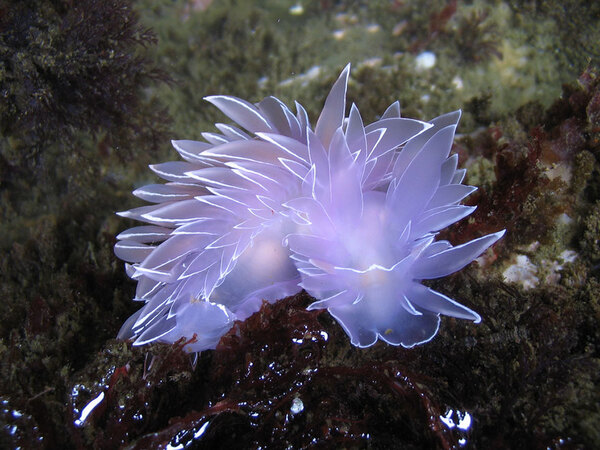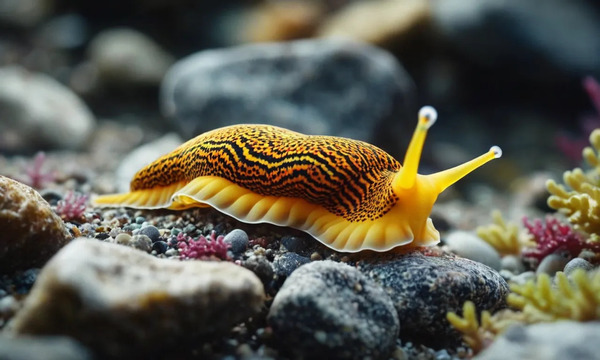Sea slugs, known scientifically as nudibranchs, are some of the most captivating creatures in the ocean. These soft-bodied, often brightly colored mollusks come in a wide variety of shapes, sizes, and colors, making them a favorite among divers and underwater photographers. But there’s much more to these marine wonders than just their looks. This article will dive deep into the world of sea slugs, exploring what they are, where they live, what they eat, and why they're so interesting to scientists and ocean lovers alike.
Sea slugs belong to the class Gastropoda, which also includes snails. However, unlike their shelled relatives, most sea slugs either have lost their shells or never had them at all. Instead of relying on a hard exterior for protection, they often use toxins, camouflage, or bright colors to ward off predators. This is part of what makes sea slugs so unique—they've evolved fascinating survival strategies in the absence of a shell.
There are several types of sea slugs, but nudibranchs are the most well-known. The word "nudibranch" means "naked gills," referring to the fact that these animals have external gills exposed on their bodies. These gills come in a variety of shapes and forms, adding to the sea slug's exotic appearance.

Sea slugs are found all over the world, from tropical coral reefs to cold ocean waters. They are most commonly spotted in shallow waters, where they feed on algae, sponges, and other small marine organisms. Some species have adapted to live in deep-sea environments, where they scavenge for food and avoid predators.
In tropical regions, such as the Great Barrier Reef, sea slugs are particularly abundant. Their vibrant colors and intricate patterns make them stand out against the coral and seaweed. In colder regions, sea slugs tend to be more subdued in color, blending into their surroundings for protection.
Sea slugs have a varied diet depending on the species. Some are herbivores, feeding on algae and sea plants. Others are carnivorous, preying on small aquarium/52-marine-animals.html">marine animals like sponges, anemones, or even other sea slugs. A few species have developed symbiotic relationships with certain types of algae, absorbing the algae’s chloroplasts to harness sunlight for energy through a process similar to photosynthesis.
One of the most amazing things about sea slugs is their ability to steal defenses from their prey. For example, some nudibranchs that eat jellyfish or sea anemones can take the stinging cells from their prey and use them for their own protection, storing them in their bodies without being harmed.
Sea slugs play a crucial role in marine ecosystems. By feeding on algae, sponges, and other organisms, they help keep these populations in check, which in turn helps maintain the balance of the ecosystem. Additionally, their presence in an area can be an indicator of water quality and environmental health, as they are sensitive to changes in their surroundings.
Sea slugs are also of great interest to scientists. Their unique chemical defenses have potential applications in medicine. Researchers are studying these compounds for their potential to treat various diseases, including cancer.
One of the most striking features of sea slugs is their brilliant coloration. While some species use bright colors as a warning to predators that they are toxic, others use it as camouflage, blending into coral reefs or seaweed. These colors can range from deep blues and purples to neon yellows and oranges, making them a visual treat for anyone lucky enough to spot them underwater.
Some species, like the Glaucus atlanticus or blue dragon, are particularly famous for their striking appearance. This sea slug floats on the surface of the ocean and feeds on venomous jellyfish like the Portuguese man o' war, storing the jellyfish's stinging cells in its own body for defense.

Here’s a table showcasing different types of Sea Slugs (Nudibranchs) and their key characteristics:
| Species | Scientific Name | Habitat | Appearance | Diet | Special Traits |
|---|---|---|---|---|---|
| Blue Dragon | Glaucus atlanticus | Surface of tropical and subtropical oceans | Bright blue, silver belly, and cerata resembling wings | Feeds on venomous jellyfish, including Portuguese man o' war | Stores venomous stinging cells from prey in its body for defense |
| Spanish Dancer | Hexabranchus sanguineus | Coral reefs in the Indo-Pacific | Large, bright red or pink body, wavy mantle | Feeds on sponges | Able to swim by undulating its body like a "dance" |
| Splendid Nudibranch | Chromodoris splendida | Coral reefs in Australia | White body with red spots and yellow-edged mantle | Feeds on sponges | Releases toxins to deter predators |
| Fire Sea Slug | Felimare picta | Mediterranean Sea and Atlantic Ocean | Deep blue body with yellow lines and spots | Feeds on sponges | Bright colors warn predators of its toxicity |
| Purple Sea Slug | Flabellina iodinea | Pacific coast of North and Central America | Vibrant purple body with orange-tipped cerata | Feeds on hydroids | Can store stinging cells from its prey for protection |
| Clown Nudibranch | Triopha catalinae | Pacific coast of North America | Orange body with white and black spots | Feeds on bryozoans | Has multiple gills along its body for breathing |
| Lettuce Sea Slug | Elysia crispata | Caribbean and Gulf of Mexico | Leaf-like appearance, green with frilly edges | Feeds on algae | Can photosynthesize by storing chloroplasts from algae in its cells |
| Red-spotted Nudibranch | Goniobranchus reticulatus | Indo-Pacific regions | White body with red spots and yellow edges | Feeds on sponges | Bright colors signal its toxicity to predators |
| Neon Sea Slug | Nembrotha kubaryana | Coral reefs in the Indo-Pacific | Black body with neon green and orange markings | Feeds on ascidians | Emits toxins when threatened |
| Hopkin’s Rose Nudibranch | Okenia rosacea | Pacific coast of North America | Pink, rose-colored body with papillae | Feeds on bryozoans | Its vibrant color acts as a warning to predators |
This table highlights some of the diverse species of sea slugs, along with their habitats, appearances, diets, and unique traits that help them survive in various marine environments.
Here’s a comparison table highlighting the key differences between Sea Slugs and Land Slugs:
| Feature | Sea Slugs | Land Slugs |
|---|---|---|
| Habitat | Marine environments (oceans, coral reefs, seagrass beds) | Terrestrial environments (gardens, forests, moist areas) |
| Scientific Class | Gastropoda (often Nudibranchia) | Gastropoda |
| Shell Presence | Most have no shell or a very reduced one | Some have an internal shell or no shell |
| Coloration | Bright, vibrant colors (blue, yellow, pink, etc.) | Typically dull colors (brown, grey, black) |
| Respiration | Gills or other specialized respiratory structures | Breathes through a respiratory pore (pneumostome) |
| Diet | Algae, sponges, anemones, sometimes other sea slugs | Plant material, decaying vegetation, fungi |
| Defensive Mechanism | Toxic secretions, ability to steal stinging cells from prey | Slime secretion to deter predators |
| Size | Can range from a few millimeters to over 30 cm (12 inches) | Typically smaller, around 2-10 cm (1-4 inches) |
| Movement | Moves using a muscular foot, glides over surfaces | Moves using a muscular foot, leaving a slime trail |
| Reproduction | Hermaphroditic, lay egg masses in gelatinous strings | Hermaphroditic, lay clusters of eggs in moist soil |
| Notable Examples | Glaucus atlanticus (Blue Dragon), Chromodoris species | Limax maximus (Leopard Slug), Arion ater (Black Slug) |
This comparison highlights the differences in habitat, physical traits, diet, and defensive mechanisms between sea slugs and land slugs.

Sea slugs (specifically nudibranchs) are gaining popularity as unique marine pets due to their fascinating colors and delicate beauty. However, keeping sea slugs as pets can be challenging, as they have specific care needs that differ from more common marine species. Here’s a guide on how to care for pet sea slugs, including tank setup, feeding, and general care tips.
Not all sea slugs are suitable for home aquariums, so it’s essential to choose species that adapt well to captivity and are easier to care for. Some popular choices for beginners include:
Lettuce Sea Slug (Elysia crispata) – Known for its ability to absorb chloroplasts from algae, this species has an attractive, leaf-like appearance and is relatively low-maintenance.
Berghia Nudibranch (Berghia stephanieae) – Commonly kept by marine hobbyists due to its diet of Aiptasia anemones, which are common aquarium pests.
These species are relatively more manageable and may thrive in controlled environments with proper care.
Sea slugs need a well-maintained, stable marine environment. Here are the tank requirements:
Tank Size: A minimum of 10 to 20 gallons is recommended, depending on the sea slug species.
Water Quality: Sea slugs are highly sensitive to water quality, so regular testing for parameters like pH (8.0-8.4), salinity (1.023-1.025), ammonia, nitrites, and nitrates is essential. Keep ammonia and nitrites at zero and nitrates as low as possible.
Temperature: Most sea slugs prefer temperatures around 72-78°F (22-26°C), but always check species-specific needs.
Filtration and Flow: Ensure low to moderate water flow. A gentle current is preferable to prevent stress or damage to the delicate body of the slug.
Lighting: Some sea slugs, like the Lettuce Sea Slug, benefit from moderate lighting to support their algae-based diet.
Diet varies significantly by species, so it’s vital to provide the appropriate food source:
Herbivorous Sea Slugs: Species like the Lettuce Sea Slug feed on algae, specifically the types that can sustain photosynthesis within their bodies. You may need to provide algae supplements if natural growth is insufficient.
Carnivorous Sea Slugs: Many nudibranchs are carnivorous, with specific diets. For example, Berghia Nudibranchs consume Aiptasia anemones. Ensure a reliable food source, as they may not adapt to other types of food.
Maintaining a consistent food source is crucial, as a lack of proper nutrition can lead to health issues in sea slugs.
Sea slugs are delicate and may be easily stressed or harmed by other tank inhabitants. Here’s what to consider:
Avoid Aggressive Species: Fish and invertebrates that nip or pick at tank mates can harm sea slugs.
Ideal Tank Mates: Small, peaceful fish and non-aggressive invertebrates like snails and hermit crabs may coexist safely with sea slugs.
Regular Water Changes: Perform regular water changes (20% monthly) to maintain water quality and keep the environment stable.
Observation: Sea slugs are sensitive to their environment, so watch for signs of stress, color fading, or reduced activity, which may indicate water quality issues or insufficient food.
Handle Carefully: Sea slugs have delicate bodies and should not be handled unless necessary. Use a soft net if needed.
Caring for pet sea slugs can be a rewarding but intricate process that requires commitment to maintaining their environment and diet. By choosing species compatible with aquarium life and following best practices for tank setup, feeding, and maintenance, you can enjoy the beauty of these fascinating creatures while providing them with a healthy, stable habitat.
Sea slugs are not only beautiful but also vital to marine ecosystems and intriguing to scientists due to their unique survival strategies and chemical defenses. Whether you're a diver, marine biologist, or simply someone who loves the wonders of nature, sea slugs offer endless fascination.
From their stunning colors to their remarkable adaptations, sea slugs remind us that the ocean is full of surprises. So, the next time you explore the ocean, keep an eye out for these incredible creatures—they might just be hiding in plain sight!
animal tags: Sea-Slugs
We created this article in conjunction with AI technology, then made sure it was fact-checked and edited by a Animals Top editor.